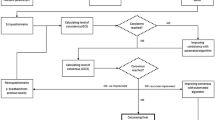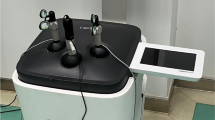Abstract
Background:
The recent focus on quality of care and patient safety has been accompanied by increased interest in standardizing the training for laparoscopic surgeons. Studies have shown that laparoscopic simulators can be used to train surgical skills. Therefore, we designed an experiment to compare the effectiveness of two popular training systems. One system was based on a physical model, whereas the other used a virtual reality model.
Methods:
A total of 32 medical students and residents were tested on both simulators. Time required for task completion and number of errors committed were recorded and compared.
Results:
The physical training system differentiated among experience levels on three of the five tasks when time was used as a measure and four of five tasks when score was used, whereas the virtual reality system yielded statistically significant results in eight of 13 tasks for time and in five of 13 tasks for score.
Conclusion:
The physical model is more sensitive than the virtual reality one in detecting differences in levels of laparoscopic surgical experience.
Similar content being viewed by others
References
MJ Ackerman VM Spitzer AL Scherzinger DG WMtlock (1995) ArticleTitleThe Visible Human dataset: an image resource for anatomical visualization Medinfo 8 1195–1198 Occurrence Handle8591405
G Ahlberg T Heikkinen L Iselius C-E Leijonmarck J Rutqvist D Arvidsson (2002) ArticleTitleDoes training in a virtual reality simulator improve surgical performance? Surg Endosc 16 126–129 Occurrence Handle10.1007/s00464-001-9025-6 Occurrence Handle11961622
R Berguer (1996) ArticleTitleErgonomics in the operating theatre Am J Surg 171 385–386 Occurrence Handle10.1016/S0002-9610(97)89614-6 Occurrence Handle8604826
R Berguer DL Forkley WD Smith (1999) ArticleTitleErgonomic problems associated with laparoscopic surgery SurgEndosc 13 466–468
M Bridges DL Diamond (1999) ArticleTitleThe financial impact of teaching surgical residents in the operating room Am J Surg 177 28–32 Occurrence Handle10.1016/S0002-9610(98)00289-X Occurrence Handle10037304
J Coleman CC Nduka A Darzi (1994) ArticleTitleVirtual reality and laparoscopic surgery Br J Surg 81 1709–1711 Occurrence Handle7827924
AM Derossis GM Fried M Abrahamowicz HH Sigman JS Barkun JL Meakins (1998) ArticleTitleDevelopment of a model for training and evaluation of laparoscopic skills Am J Surg 175 482–487 Occurrence Handle10.1016/S0002-9610(98)00080-4 Occurrence Handle9645777
GM Fried AM Derossis J Bothwell HH Sigman (1999) ArticleTitleComparison of laparoscopic performance in vivo with performance measured in a laparoscopic simulator Surg Endosc 13 1077–1081 Occurrence Handle10.1007/s004649901176 Occurrence Handle10556441
AG Gallagher K Richie N McClure J McGuigan (2001) ArticleTitleObjective psychomotor assessment of experienced, junior and novice laparoscopists with virtual reality World J Surg 25 1478–1483 Occurrence Handle10.1007/s00268-001-0133-1 Occurrence Handle11760752
AG Gallagher EM Ritter RM Satava (2003) ArticleTitleFundamental principles of validation, and reliability: rigorous science for the assessment of surgical education and training Surg Endosc 17 1525–1529 Occurrence Handle10.1007/s00464-003-0035-4 Occurrence Handle14502403
TP Grantcharov VB Kristiansen J Bendix L Bardram J Rosenberg P Funch-Jensen (2004) ArticleTitleRandomized clinical trial of virtual reality simulator for laparoscopic skills training Br J Surg 91 146–150 Occurrence Handle10.1002/bjs.4407 Occurrence Handle14760660
EAM Heijnsdijk A Pasdeloup AJ van der Piji J Dankelman DJ Gouma (2004) ArticleTitleThe influence of force feedback and visual feedback in grasping tissue laparoscopically Surg Endosc 18 980–985 Occurrence Handle15108104
H Hoffman V Dzung (1997) ArticleTitleVirtual reality: teaching tool of the twenty-first century? Acad Med 12 1076–1081
R McC1oy R Stone (2001) ArticleTitleVirtual reality in surgery BMJ 323 912–915 Occurrence Handle10.1136/bmj.323.7318.912 Occurrence Handle11668138
Y Munz BD Kumar K Moorthy S Bann A Darzi (2004) ArticleTitleLaparoscopic virtual reality and box trainers: is one superior to the other? Surg Endosc 18 485–494 Occurrence Handle10.1007/s00464-003-9017-9 Occurrence Handle14752633
DJ Scott PC Bergen RV Rege R Laycock ST Tesfay RJ Valentine DM Euhus et al. (2000) ArticleTitleLaparoscopic training on bench models: better and more cost effective than operating room experience? J Am Coll Surg 191 272–283 Occurrence Handle10.1016/S1072-7515(00)00339-2 Occurrence Handle10989902
NE Seymour AG Gallagher SA Roman MK O’Brien VK Bansal DK Andersen RM Satava (2002) ArticleTitleVirtual reality training improves operating room performance: results of a randomized, double-blinded study Ann Surg 236 458–464 Occurrence Handle10.1097/00000658-200210000-00008 Occurrence Handle12368674
Acknowledgments:
This work was supported by the National Science Foundation under grant 0238284. We also acknowledge the participation of the residents at Tufts–New England Medical Center and Stamford Hospital and the students of the Tufts School of Medicine.
Author information
Authors and Affiliations
Corresponding author
Rights and permissions
About this article
Cite this article
Avgerinos, D.V., Goodell, K.H., Waxberg, S. et al. Comparison of the sensitivity of physical and virtual laparoscopic surgical training simulators to the user’s level of experience. Surg Endosc 19, 1211–1215 (2005). https://doi.org/10.1007/s00464-004-8256-8
Received:
Accepted:
Published:
Issue Date:
DOI: https://doi.org/10.1007/s00464-004-8256-8




